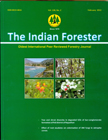Community Structure, Species Niche Width and Soil Characteristics in a Transitional Zone of Sub-tropical Forest
DOI:
https://doi.org/10.36808/if/2012/v138i2/4601Keywords:
Species Niche Width, Transitional Zone, Sub-tropical Forest, Anogeissus latifolia, Pinus roxburghiiAbstract
The study was carried out in the transitional zone of Anogeissus latifolia and Pinus roxburghii forests to understand the forest community structure, species niche width and soil characteristics. Three different forest types i.e., Pure Anogeissus latifolia (PAL) and Pure Pinus roxburghii (PPR) and mixed forest of Anogeissus latifolia and Pinus roxburghii (M.AL&PR) were reported in the study area. The soil pH was alkaline (7.26) in PPR forest followed by neutral (7.0) in M.AL&PR forest and acidic (6.76) in PAL forest. Soil organic carbon was 0.52±0.05 % highest in PAL forest followed by M.AL&PR forest (0.50±0.17%) and lowest in PPR (0.41±0.02%) forest. The phosphorus (31.68 kg/ha) and potassium (196 kg/ha) were the highest in M.AL&PR forest followed by PAL (31.58 kg/ha for phosphorus and 167.63 kg/ha for potassium) and PPR (23.09 kg/ha for phosphorus and 153.07 kg/ha for potassium) forests. Among the trees, the highest niche width was reported for Anogeissus latifolia (1.98) followed by Pinus roxburghii (1.96) and in shrub layer the niche width of Carissa opaca (2.45) was quite high compared to other shrubs species. The soil conditions in transition zone favoured the growth of diverse species composition.Downloads
Download data is not yet available.
Downloads
Published
2012-02-01
How to Cite
Kumar, M., Kumar, S., Sheikh, M. A., & Gusain, M. S. (2012). Community Structure, Species Niche Width and Soil Characteristics in a Transitional Zone of Sub-tropical Forest. Indian Forester, 138(2), 154–158. https://doi.org/10.36808/if/2012/v138i2/4601
Issue
Section
Articles
License
Unless otherwise stated, copyright or similar rights in all materials presented on the site, including graphical images, are owned by Indian Forester.





